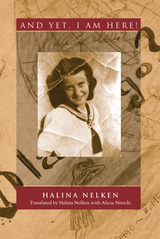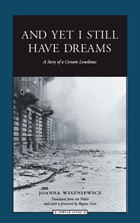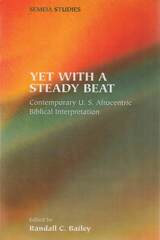3 books about Yet

And Yet, I Am Here!
Halina Nelken
University of Massachusetts Press, 2001
When Germany invaded Poland in 1939, Halina Nelken was a precocious fifteen-year-old, living a middle-class life in Krakow. Like other girls her age, she recorded her personal observations and feelings in a diary. As conditions in Krakow deteriorated and her family was forced into the Jewish ghetto, she continued to write, eventually smuggling her diary out with a Catholic friend. This remarkable book tells the story of Nelken's experiences in the ghetto and later in eight Nazi concentration camps, including Plaszow, Auschwitz, and Ravensbröck. Her diary entries, written between 1938 and 1943, form the core of the volume and are supplemented by recollections written shortly after the war, and by later commentaries and explanatory notes which she added in the mid-1980s. Although there exist numerous published and unpublished memoirs by Holocaust survivors, Nelken's book presents one of the few extant diaries written at the time. Already released in Polish and German editions, it has been hailed as one of the finest works of its kind. Now it is available in English for the first time.
[more]

And Yet I Still Have Dreams
A Story of Certain Loneliness
Joanna Wiszniewicz
Northwestern University Press, 2004
And Yet I Still Have Dreams is a departure from many Holocaust memoirs and biographies. Based on interviews with "Alex," an anonymous survivor of the Warsaw Ghetto and three concentration camps, the story follows him from his assimilated childhood to his coming to terms with his memories of the Holocaust as an older man. Alex is angry, pugnacious, and contemptuous of the stereotypes found in some survivor literature and honest about the shortcomings of other works.
The book provides a connection to seldom discussed aspects of the Holocaust: the gulf between rich and poor Jews and how this translated into everyday survival; the refusal by Alex to see himself or Jews in general as heroes or victims; his own self-absorption as a teen in the ghetto; and his "priviliged" family's near-indifference to the suffering of those around them. Alex paints a picture of complex and diverse Jewish society in prewar Poland, revealing how, many years later and despite his determine to leave it in the past, the burdens of memory--and the dreams--linger.
The book provides a connection to seldom discussed aspects of the Holocaust: the gulf between rich and poor Jews and how this translated into everyday survival; the refusal by Alex to see himself or Jews in general as heroes or victims; his own self-absorption as a teen in the ghetto; and his "priviliged" family's near-indifference to the suffering of those around them. Alex paints a picture of complex and diverse Jewish society in prewar Poland, revealing how, many years later and despite his determine to leave it in the past, the burdens of memory--and the dreams--linger.
[more]

“Yet with a Steady Beat”
U. S. Afrocentric Biblical Interpretation
Randall C. Bailey
SBL Press, 2003
This collection of essays exemplifies new directions being taken by biblical scholars using new literary, historical, and sociological critical tools to explore issues of concern to their communities and thus poses a challenge to others in the discipline to broaden the canons of interpretation and sources. The essays, from the generation of scholars following the writers of the historic Stony the Road We Trod: African American Biblical Interpretation (Fortress, 1991), address issues of cultural criticism, utilization of Black religious sources such as the Negro spirituals and sermons, histories of struggles of Afro-diasporan peoples, and ideological criticism in interpreting the biblical text.
This collection of essays exemplifies new directions being taken by biblical scholars using new literary, historical, and sociological critical tools to explore issues of concern to their communities and thus poses a challenge to others in the discipline to broaden the canons of interpretation and sources. The essays, from the generation of scholars following the writers of the historic Stony the Road We Trod: African American Biblical Interpretation (Fortress, 1991), address issues of cultural criticism, utilization of Black religious sources such as the Negro spirituals and sermons, histories of struggles of Afro-diasporan peoples, and ideological criticism in interpreting the biblical text.
[more]
READERS
Browse our collection.
PUBLISHERS
See BiblioVault's publisher services.
STUDENT SERVICES
Files for college accessibility offices.
UChicago Accessibility Resources
home | accessibility | search | about | contact us
BiblioVault ® 2001 - 2024
The University of Chicago Press









